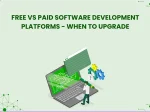Web Application Development | Choosing the Right Tech Stack

Have you ever wondered what powers the websites and mobile apps you use every day? Most people don’t. Yet every time you experience a smooth interaction, it’s because of the effective tech stack managing all the background work.
A tech stack is a collection of tools used to develop, run, and maintain an application. It handles everything — from what users see on the front end to how the app functions behind the scenes. Choosing the right mobile app architecture JavaScript is crucial for building scalable, maintainable, and high-performance web and mobile applications.
Picking the right setup isn’t just helpful — it’s essential for ensuring that your app performs well today and remains adaptable for future growth. Web and mobile application development have changed fast in recent years. That’s where choosing the right application development software comes in.
An API integration software platform connects different tools and systems seamlessly, helping developers build faster, automate workflows, and create scalable web and mobile applications with less manual effort.
From mobile phone application development to enterprise-level systems, the tools you use shape your app’s success.
In this blog, we’ll help you find the best fit for your project. Whether you need custom mobile application development or a multi platform mobile application development solution, we’ll break it down clearly.
You’ll also learn about current JavaScript frameworks and why tech choices impact performance, cost, and user experience. So, whether you’re a solo developer or part of an application development company, this guide will point you in the right direction. Let’s dive in.
Current Trends in Web and Mobile Application Development
Web and application development for mobile is evolving fast. Users now expect clean design, quick performance, and smooth interactions. Developers now rely on better tools and quicker workflows to keep up with user needs.
Mobile phone application development and web platforms often use the same technologies. This saves time and helps to build applications more efficiently. React, Vue, and Angular still dominate frontend development.
Top backend tools include Django, Spring Boot, and Node.js. They are great for Complex tasks and real-time features. They’re often used by businesses to create safe systems.
Flutter and React Native have become popular choices in cross platform mobile application development. They let you write code once and run it across Android and iOS devices. This saves time and cuts costs.
Progressive Web Apps are gaining ground, too. They let users run apps right in the browser, just like a native app. DevOps and CI/CD are now standard in mobile app development because they help teams build, test, and release updates faster. They help release updates faster and with fewer errors.
Custom mobile app development keeps moving things forward. Developers are now building apps that load quicker and feel smoother for users.
Frameworks like React and Vue.js dominate front-end development. On the other hand, Node.js and Django excel on the back end.
Key Factors for Choosing a Tech Stack
Choosing the right tech stack isn’t just about what’s trending. It is dependent upon the real requirements of your project. Scalability, performance, and the knowledge of your team are all important.
For mobile application development, your platform should support multiple devices and screen sizes. The best mobile application development software gives you speed without sacrificing control. That’s important when deadlines are tight.
Flexibility is key. Weeks of work can be saved with a tech stack that makes transitioning simple. This is especially important when developing custom mobile applications because requirements change frequently.
Strong documentation and active developer communities are essential. They help fix problems quickly and keep your team moving. A custom application development company can’t afford to waste time digging through weak resources.
You should also check how well your stack supports APIs and external tools. Integration matters. Web and application development companies often rely on tools that need to work together.
Choose tools that work today and grow with you tomorrow. That’s the core of smart, future-ready development.
Leading Web Frameworks in 2026
Explore the best web development frameworks driving custom web application development, cross platform mobile apps, and enterprise application development in 2026.
Ext JS
Ext JS, short for Extended JavaScript, is perfect for enterprise application development where data complexity is high. It offers strong tools for managing large UIs. Built-in components reduce time spent on design.
Version 7.7 improved accessibility, grid behavior, and chart rendering. You also get theming support using Sencha Themer. These updates enhance productivity for enterprise teams.
It’s well-suited for multi platform mobile application development. It can be tough for new developers to pick up. For small teams, it might be more than what the project really needs.
You may check further details on the Sencha website.
Custom application development teams often choose Ext JS for its solid data handling. It also makes building responsive, user-friendly layouts easier. Its enterprise-grade features make it stand out.
If you need enterprise-level UI with strong data features, this is one of the best application development software options. Despite some cons, it offers unmatched power. Teams working on enterprise and custom application development will find it useful.
Also Read: How to Add a JavaScript Pivot Grid to Your Web Application
Vue.js
Vue.js keeps things simple and flexible. It works well for relatively small mobile or web projects. Getting started with Vue CLI takes no time.
Vue uses reactive data binding, making UI or user interface changes more obvious. Its component-based structure and libraries keep code clean. Developers love its simplicity.
It is good for developing both iOS and Android applications. Vue Router and Vuex help keep navigation and app state easy to manage. It works well for building dynamic, interactive interfaces.
Vue supports custom mobile application development by offering modular and scalable code. Teams can launch fast without cutting corners. It scales with project needs.
Many developers prefer Vue for custom web application development. It hits a nice balance between being powerful and easy to use. Even less experienced teams can build solid, well-functioning apps with it.
If you’re looking for mobile application development platforms that are easy to learn, Vue is a smart pick. It’s also ideal for application development companies that want clean, maintainable codebases.
React.js
React.js is one of the greatest choices for designing UI. Developers globally make use of it, and Meta supports it. A lot of major apps rely on it.
It’s virtual DOM ensures fast updates. JSX helps in keeping the UI design readable and efficient. Because of these reasons, it’s perfect for modern mobile and web interfaces.
React Native extends React for mobile app development. It supports cross platform mobile application development using one codebase. This makes it ideal for startups and big companies alike.
React makes Custom mobile application development so easy. It works nicely with tools such as Redux and Webpack. Developers can optimize performance and structure easily.
A lot of custom app development teams use React. It’s fast and adaptable. Also, backed by a strong community. It also works great for building hybrid mobile apps.
For application development software that scales, React is a solid choice. It supports fast iteration, great user experience, and multi platform compatibility.
Backend Technologies and Frameworks
These tools power the server side of mobile and web applications. They handle data, security, logic, and performance efficiently.
Node.js
Node.js is perfect for real-time mobile application development. It uses JavaScript on the backend and handles many tasks without slowing down.
You’ll see it used in chats, streaming apps, or dashboards because it stays quick and doesn’t slow things down. Node.js is often used for mobile apps that need to handle a lot of users. It runs smoothly on both iOS and Android.
Django
Django is very useful in building secure and quick websites. It’s written in Python and includes built-in admin tools, user management, and ORM, which is Object-Relational Mapping.
Many application development companies trust Django since it’s perfect for websites with a lot of content. It’s an ideal choice for quick project delivery and the creation of unique mobile applications.
Spring Boot
Spring Boot is a solid choice for building large-scale Java apps in enterprise environments. It’s safe to use, easy to scale, and simple to set up. It is ideal for complex applications because of REST APIs and microservices.
Many custom application development companies use Spring Boot for cross platform mobile application development and web-based enterprise tools.
Full-Stack Solutions
Full-stack development means building both the user interface and the backend parts of an app. It enables teams to work more quickly and effectively. Using the same language across the stack just makes everything easier to manage and connect.
Popular stacks include:
- MEAN (MongoDB, Express, Angular, Node.js)
- MERN (MongoDB, Express, React, Node.js)
Stacks like these are common in mobile projects that run on both iOS and Android. They help cut down extra work by reusing code. For custom apps, they keep things straightforward and aligned.
Also Read: UI Components by Ext JS to Create A Stunning Mobile App
The Power of Community and Ecosystem
A strong developer community means better tools and fewer bugs. It also helps developers stay updated. There are large ecosystems for React, Vue, and Node.js. They provide an extensive range of support channels, integrations, and plugins.
For mobile application development solutions, strong communities mean faster updates and better SDK support. This is key for application development companies.
One more thing, documentation and third-party resources are also very important. A healthy ecosystem ensures long-term success and support.
How to Choose the Right Tech Stack
Think about what you’re building before picking your tools. Is it a simple prototype or a full-scale enterprise app? That decision drives everything else you choose.
Know your team’s strengths. Pick mobile platforms that actually fit what you’re building and where you’re headed. If your team can’t handle it, don’t use it.
Check how frequently the specific tool is used. Look at GitHub, recent updates, and real developer feedback. Join forums or Slack channels to learn from others already using it.
Choosing the right tools is not about what’s trending. It actually means go for tools that match your project requirements.
Conclusion
Today, choosing the right tech stack is really important for building the project smoothly. Whether you’re building for the web or mobile, every tool you pick affects speed, user experience, and scalability.
Frontend frameworks like React, Vue, and Ext JS give structure and style to your app. Backend frameworks like Django and Node.js bring speed and reliability. Full-stack combinations ensure smooth delivery from start to finish.
A good tech stack also supports cross platform mobile application development. This means less work and more reach. Don’t forget community support, integration options, and future scalability.
Whether you’re a startup or a large application development company, use this guide as a reference. If you work with a web and application development company, keeping things flexible and focused is key. Build solutions that last.
FAQs
What Is Cross Platform Mobile Application Development?
It’s about developing an application that runs on both Android and iOS. So it uses one codebase, which saves time and cost.
How To Choose a Mobile Application Development Company?
Check how they handle unique projects, how good they are with technology, what past clients say, and their previous work.
What Is API in Mobile Application Development?
An API lets your app talk to other services like databases or payment gateways using standard protocols.
What Is Intent in Mobile Application Development?
In Android apps, an intent is just how one part asks another to do something, like open a new screen or share info.
What Technologies Are Used for Mobile Application Development?
People often use tools like Flutter, React Native, Kotlin, and Swift to build apps. For the backend, things like Firebase and Node.js are popular choices.
What Is RAD (Rapid Application Development)?
RAD means delivering the first version quickly. Then fix it according to the user’s needs. It helps get things done faster.
What Are the Challenges of Enterprise Application Development?
Complex integration, security concerns, scalability, and user adoption are top challenges in enterprise projects.
What Is Low Code Application Development?
It allows you to build an application using prebuilt elements. You just drag and drop them. So, there is no need to write code.
How Do Native Platforms Handle Cross-Platform Development?
They don’t by default. Tools like React Native bridge the gap to run shared code across platforms.
Is Application Development the Same as Software Development?
Not exactly. Application development focuses on user-facing apps, while software development includes all types of system software.
Sign Up at Sencha Ext JS – Develop highly scalable web apps today!

The selection of a front end framework for enterprise applications remains one of the most…

Every software project begins with a choice that reverberates through its entire lifecycle: which development…

Building software for regulated industries demands more than functional code. Healthcare organizations must protect patient…









